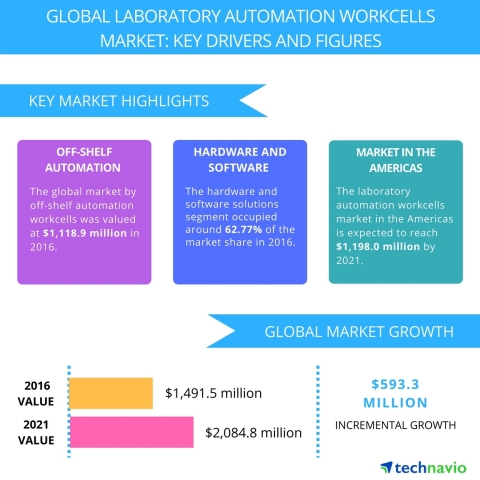LONDON--(BUSINESS WIRE)--Technavio’s latest market research report on the global laboratory automation workcells market provides an analysis of the most important trends expected to impact the market outlook from 2017-2021. Technavio defines an emerging trend as a factor that has the potential to significantly impact the market and contribute to its growth or decline.
The global laboratory automation workcells market is expected to grow at a CAGR of close to 7% during the forecast period. At present, the stakeholders of laboratories are opting for automation for improved operations as well as well-directed experiments. This is expected to drive the growth of the market.
According to Bharath Kanniappan, a lead analyst at Technavio for automation research, “The need for environmental controls in laboratories will drive the adoption of automated workcells. Adopting workstations will facilitate less manual contact with the specimen, leading to minimal cases of the lab technicians or personnel being infected. Workstations are entirely closed systems with one inlet for specimen entry and another exit point for proper collection of disposals.”
This report is available at a USD 1,000 discount for a limited time only: View market snapshot before purchasing
Buy 1 Technavio report and get the second for 50% off. Buy 2 Technavio reports and get the third for free.
The top three emerging market trends driving the global laboratory automation workcells market according to Technavio research analysts are:
- Emergence of laboratory automation control interface
- Increased use of cell-based assay
- Rise in implementation of IoT in laboratories
Looking for more information on this market? Request a free sample report
Technavio’s sample reports are free of charge and contain multiple sections of the report including the market size and forecast, drivers, challenges, trends, and more.
Emergence of laboratory automation control interface
Lab automation workcells requires an interface known as the Laboratory information management system (LIMS) to provide necessary information to the user. LIMS software stores, reports, and manages data of a batch of samples tested for drug trials and of other complex aspects of an experiment. This enables effective management of sample specimens and improves lab efficiency.
LIMS plays a major role in facilitating the real-time operation. The software can induce asynchronous functioning of all the devices and equipment. Automation control interface in laboratories drives hardware components. The interface helps in collecting patient information sources and achieving the goal of delivering optimum outcomes with maximum use of laboratory resources.
Increased use of cell-based assay
A cell-based assay is the phenomenon of several experiments taking place simultaneously based on the use of live cells. The experiments are primarily carried out to measure cell proliferation, motility, toxicity, production, and morphology of a specimen. At present, there is significant use of the cell-based assay for drug discovery.
“Cell-based assays offer an accurate real-life representation of the behavior of live cells. Cell-based assays are required to analyze millions of samples per day. This calls for a need for laboratory automation workcells, which can support a high rate of productivity,” says Bharath.
Rise in implementation of IoT in laboratories
The IoT has proliferated into many industries, and now, this technology is also being applied in laboratory automation. It has a major implication for creating a smarter healthcare infrastructure globally. Some of the wearable devices, connected with the IoT, can detect health problems and immediately refer drugs or send detailed information to emergency responders and family members of patients. The implementation of IoT is inducing the creation of smarter laboratories, leading to the creation of the Internet of Laboratory Things (IoLT).
The IoLT enables experts to operate automated workcells from anywhere and at any time. If a specimen needs to be in a freezer for 12 hours, a lab technician can give a command for the further progress of the experiment, in advance and the experiment will be executed after completion of 12 hours. In such a case, the technician can control the progress of the experiments through the information received on his or her tablet or mobile phone that is aligned with laboratory workcells. The technician can decide the status of the specimen from his or her own room and direct the progress. This type of remote monitoring has only been possible with the implementation of the IoT with automated workstations in laboratories.
Browse Related Reports:
- Global Emergency Shutdown Valves Market 2017-2021
- Global Fire Pump Controllers Market 2017-2021
- Global Field Devices Calibration Services Market 2017-2021
About Technavio
Technavio is a leading global technology research and advisory company. Their research and analysis focuses on emerging market trends and provides actionable insights to help businesses identify market opportunities and develop effective strategies to optimize their market positions.
With over 500 specialized analysts, Technavio’s report library consists of more than 10,000 reports and counting, covering 800 technologies, spanning across 50 countries. Their client base consists of enterprises of all sizes, including more than 100 Fortune 500 companies. This growing client base relies on Technavio’s comprehensive coverage, extensive research, and actionable market insights to identify opportunities in existing and potential markets and assess their competitive positions within changing market scenarios.
If you are interested in more information, please contact our media team at media@technavio.com.




